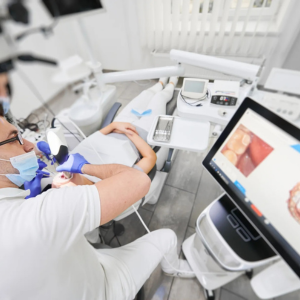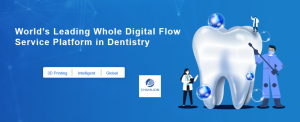The digital dentistry industry is undergoing transformative growth, poised to revolutionize how dental professionals diagnose, plan treatments, and perform procedures. According to a recent report by Fortune Business Insights, the global digital dentistry market, valued at $4 billion in 2023, is projected to reach $9.22 billion by 2032, with a compound annual growth rate (CAGR) of 9.1%. This growth is fueled by technological advancements, increasing demand for aesthetic solutions, and continuous improvements in patient experiences.
Emerging trends: The shift toward digitization

One of the most significant changes in modern dentistry is the widespread adoption of digital intraoral scanners (IOS). These tools, designed to deliver more accurate diagnoses and enhance treatment planning, are driving the shift toward fully digital workflows. IOS technology seamlessly integrates with Computer-Aided Design and Manufacturing (CAD/CAM) systems, streamlining the production of dental restorations such as crowns and bridges.
A recent example highlighted in the report is the launch of the OCH2B30 camera module by OMNIVISION in June 2024, designed for 3D intraoral scanners. Innovations like this are transforming dental practices by improving both efficiency and precision, resulting in better outcomes for patients.
Market growth drivers
Rising demand for aesthetic dentistry
The growing focus on dental aesthetics has led to an increasing number of patients opting for procedures like implants, veneers, crowns, teeth whitening, and invisible aligners. These treatments require advanced digital tools to create high-precision, customized designs.
According to the American College of Prosthodontists, approximately 2.3 million implant-supported crowns are fabricated annually in the United States. This surge in demand is significantly driving the adoption of digital technologies in dentistry.
Ongoing technological advances
The digitization of dental workflows, from impression taking to restoration fabrication, enables dentists to provide faster and more precise treatments. A notable example is the launch of the Origin One Dental 3D printer by Stratasys in 2021, designed specifically for the dental sector. These technologies not only enhance precision but also increase customization and patient comfort.
Growing public awareness
Patient education about the benefits of digital solutions has increased demand for these technologies. Informed patients are more likely to prefer advanced tools that deliver faster, more effective results.
Market growth challenges
High initial costs
The investment required for CAD/CAM systems, software, and digital scanners can be prohibitive, especially for dental practices in emerging markets. The report cites the average cost of a complete CAD/CAM system as ranging from $90,000 to $112,000.
Lack of insurance coverage
In many countries, advanced dental procedures are not covered by insurance, discouraging patients from opting for them and limiting dentists’ ability to justify investing in advanced technology.
Regional Insights: A diversified global market
The Fortune Business Insights report details how different regions are adopting digital dentistry:
- North America: Holding 38.75% of the market share in 2023, this region leads the sector due to early adoption of advanced technologies and high demand for aesthetic procedures. A recent example is the launch of the iTero Lumina intraoral scanner by Align Technology in January 2024.
- Europe: With an aging population and broader insurance coverage, Europe ranks second in market share. Countries like Germany and France are witnessing increased use of digital tools due to governmental and private initiatives aimed at improving dental care.
- Asia-Pacific: This region is projected to record the highest growth rate during the forecast period. The rapid expansion of dental clinics and oral health awareness campaigns are driving the adoption of digital solutions.
- Latin America and the Middle East/Africa: These regions are experiencing steady growth thanks to improvements in healthcare infrastructure and a focus on oral disease prevention and treatment.
The future of Digital Dentistry
The global digital dentistry market is at a turning point. Advances in 3D scanners, digital printers, and planning software are transforming the way dentistry is practiced. As more clinics adopt these technologies, the sector is expected to continue evolving toward more precise, efficient, and personalized care.
While initial costs may pose a challenge, the long-term return on investment in terms of operational efficiency and patient satisfaction is evident. With the constant introduction of innovative products and increasing demand for dental aesthetics, the future of digital dentistry looks brighter than ever.
From this perspective, digital dentistry is not only transforming dental procedures but also reshaping patient expectations and clinical outcomes. As highlighted in the Fortune Business Insights report, this is a dynamic market with immense growth potential, driven by innovation and the need for more advanced, personalized healthcare solutions.
The question is not if digital dentistry will become the standard, but when and how industry professionals will embrace this technological revolution.



